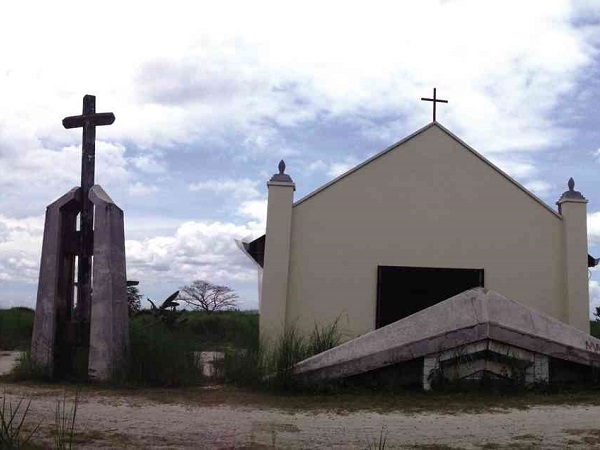151-yr-old school mirrors Bacolor resilience

TINAJERO Chapel in Barangay Tinajero, Bacolor, Pampanga E.I. REYMOND T. OREJAS/INQUIRER CENTRAL LUZON
BACOLOR, Pampanga—A 151-year-old school here has helped keep alive a public water agency even as Mt. Pinatubo’s lahar buried this former Pampanga capital after the volcano’s eruptions in June 1991.
This little-known contribution of the Don Honorio Ventura Technological State University (DHVTSU) to the survival of the Bacolor Water District (BWD) and the rebuilding of Bacolor came up as residents recalled the disaster that lingered until 1997.
“We did not stop operating because we needed to save the then DHVCAT (Don Honorio Ventura College of Arts and Trade). We thought that the students would be neglected if we stopped supplying water,” said Luciana Capili, then general manager of the BWD.
“Yes, [there was] no interruption of service even during the Pinatubo eruptions,” Dr. Enrique Baking, DHVTSU president, said.
The school, founded by Augustinian priest Juan P. Zita and civic leader Don Felino Gil on Nov. 4, 1861, began as the Escuela de Artes y Oficios de Bacolor, becoming one of the oldest vocational schools in Asia. It was built on donated lands at the southeastern bend of what was just then Gugu Creek.
The creek turned into a tributary of lahar in 1995 after previous avalanches raised the level of Pasig-Potrero River by 6 meters.
The erstwhile DHVCAT was one of the two last-standing structures after lahar, with the sound of rampaging horses and as tall as 20 meters, claimed the remaining part of Bacolor.
“As proof of the resolute commitment and resiliency of the DHVCAT community, college officials, together with faculty members, nonteaching personnel and students, collectively decided not to abandon the campus,” said Baking.
After the 1995 lahar flows, the DHVCAT was a maze of footbridges, buried buildings and makeshift rooms.
The academic community, he said, rose above the devastation and faced the challenge by reconstructing facilities and offering more courses that catered to the needs of residents from Bacolor and neighboring towns.
“We put so much importance on the school because it provided education to many Bacoloreños and helped improve our lives,” said Sergio Carreon, 70, a BWD director.
DHVTSU is every bit a modern campus now. The only trace left of the disaster is the remains of an old facade. The school is a resource for enterprising residents. They built around it new private dormitories.
DHVTSU became one of the hinges of the Bacolor rehabilitation plan, outgoing Rep. Aurelio Gonzales said.
Former President Gloria Macapagal-Arroyo signed in 2009 the law that Gonzales sponsored converting DHVCAT to DHVTSU. Don Honorio Ventura helped Arroyo’s father, the late President Diosdado Macapagal, finish law.
Capili said the disaster years saw almost nonstop work, led by engineer Rodolfo Nacpil, to recover pipelines, wells or pumps to keep the taps from drying out. Even detainees waiting for trial for crimes were mobilized for this, she said.
Water continued to flow at San Guillermo Church that, though half-buried by lahar, inspired many residents to stay or return for good.
Approved by the Local Water Utilities Administration (LWUA) to operate as the 160th water district in the country in October 1991, the BWD served 2,000 concessionaires in six of Bacolor’s 22 villages before 1991.
It was extending its services to Parulog, San Antonio, Potrero, Dolores and Duat when the eruptions occurred. These villages have been ringed by the FVR Megadike, Pampanga’s last defense against lahar.
“The LWUA was surprised upon learning that the BWD is still operational. They thought we were gone from the map,” Rico Malgapo, BWD chair, said.